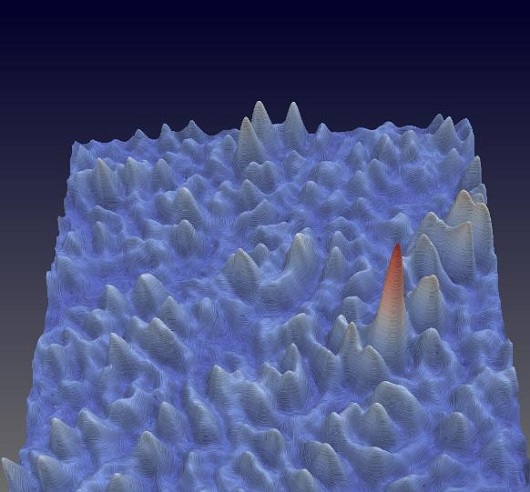Storm in a chip

A tiny chip, developed by scientists at the University of St Andrews, could help aid understanding into how rare events such as rogue waves occur.
The nano-device, which has been used to create and control rogue optical waves, has potential applications for research in energy, advanced imaging and environmental safety.
In a study published today (Monday 9 March 2015), researchers looked at those rare moments in which large amounts of energy, normally in a ‘quiet’ state, build up spontaneously to create phenomena on a potentially disastrous scale.
In a new, innovative piece of research, a team of scientists from Saudi Arabia, the Netherlands and UK, set out to understand the dynamics of such destructive events by controlling their formation in photonic crystal-based optical chips.
The team began the research by developing new theoretical ideas to explain the formation of rare energetic natural events such as rogue waves, large surface waves that develop out of the blue in deep water and represent a potential risk for vessels and open-ocean oil platforms. Specifically the researchers linked the probability of these events with the rate at which energy is lost in a chaotic sea.
Professor Fratalocchi of the King Abdullah University of Science and Technology, who led the study, said, “We wanted to demonstrate that small perturbations of a chaotic sea of interacting waves could, contrary to intuition, control the formation of rare events of exceptional amplitude.”
To test this theory, Dr Andrea Di Falco of the University of St Andrews developed a planar photonic crystal chip, which was then used to generate ultrafast (163 fs long) and subwavelength (203 mn wide) nanoscale rogue optical waves. The researchers noted that the photonic chip offered an ‘exceptional level of controllability’ over these rare events, thus proving the theory.
Dr Di Falco, leader of the Synthetic Optics group at the University’s School of Physics and Astronomy, said, “The advantage of using light confined in an optical chip is that we can control very carefully how the energy in a chaotic system is dissipated, giving rise to these rare and extreme events.
“It is as if we were able to produce a determined amount of waves of unusual height in a small lake, just by accurately landscaping its coasts and controlling the size and number of its emissaries.”
The results of the study offer leading edge technological applications that could assist with preparing for potential environmental disasters.
Professor Fratalocchi added, “This discovery can change once and for all the way we look at catastrophic events, opening new perspectives in preventing their destructive appearance on large scales, or using their unique power for ideating new applications at the nanoscale.”
“Triggering extreme events at the nanoscale in photonic seas’” is published by Nature Physics and available online at: http://dx.doi.org/10.1038/nphys3263
ENDS
NOTE TO EDITORS:
Dr Andrea Di Falco is available for interview on 01334 463165 or via email:
NOTE TO PICTURE EDITORS:
Images are available from the Press Office – contacts below.
Issued by the Press Office, University of St Andrews
Contact 01334 462530 or email [email protected]
Ref: Storm in a chip 090315
Category Research